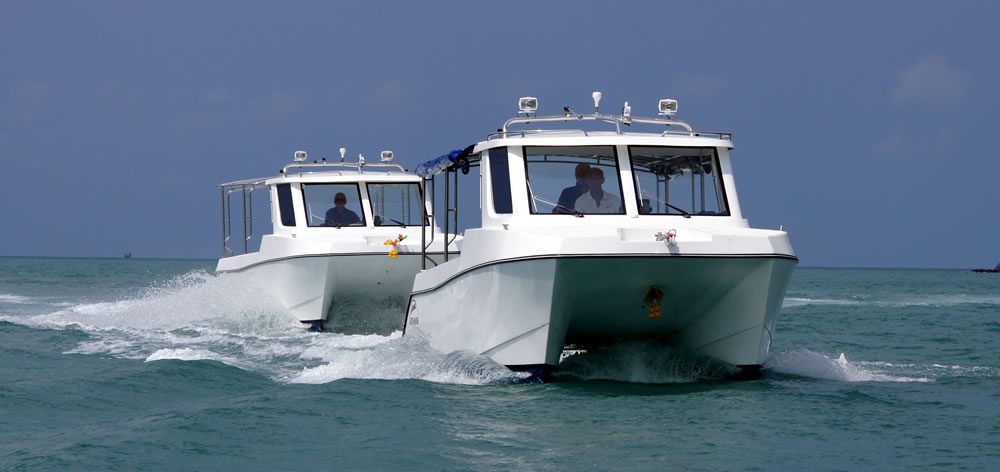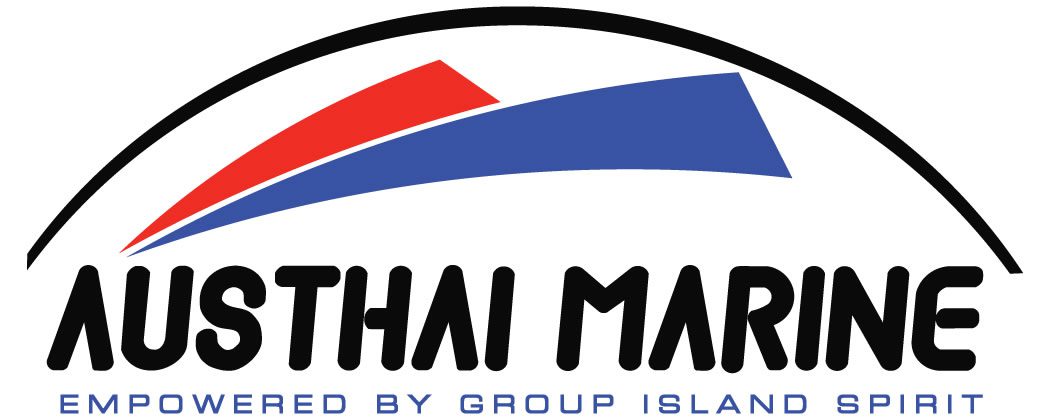
Graham Harris Journey
The 2010 year and the early part of this year have proven to be busy times for Austhai Marine. Recently completed extensions have doubled the size of our facility, and the climate controlled lamination room has also been extended to cater for increased production. A number of new models have been or are in the process of being introduced. Our local and export markets continue to expand. Two boats have been delivered to India, and boats are currently under construction for delivery to Vanuatu and the Philippines.
Two new models are currently under construction, one an 8 meter Funcat and the other a 16 meter dive boat. Further new models will be released later in the year.
We are particularly proud of the fact that the two 8 meter wide body dive cats recently delivered to Barefoot Scuba in the Andaman and Nicobar Islands were delivered under their own power. The boats were sailed from Phuket on the west coast of Thailand to Port Blair in the Andaman Islands, a voyage of 420 miles of mainly open water. The boats were delivered by World Yachting, a Phuket based operation specializing in worldwide delivery of boats (www.worldyachting.biz).
READ GRAHAM HARRIS REPORT OF THE JOURNEY:
To take two small 8 metre power boats across 420 miles of open water and out of sight of land, one has to be either stupid or have faith in the builder and the boat. As a very experienced professional delivery Captain, I like to think I am not stupid and I did have faith in the boats that Ray and his gang at Austhai Marine manufactured and we were going to deliver from Phuket in Thailand to Port Blair in the Andaman Islands.
The two brand new Austhai 800 Widebody Dive Cats that had missed the scheduled ferry service to India had meant that the owners, Barefoot Scuba India, would be losing valuable high season business so they contacted World Yachting to deliver them as quickly as possible.
After being delivered by truck from the factory overnight to Phuket, it was a matter of getting them in the water, checking them over and then out for our first test ‘drive’ and straight away we could see that they performed in every way that the builder and owners had said they would.
With full tanks (600 litres), a further 650 litres of fuel in 24 plastic containers plus 30 litres of oil filling up the cockpit, we set off early one morning under a blue sky, a gentle sea with a forecast that promised more of the same for the next few days at least.
For the first few hours and still in sight of land we changed our boat speed on the hour, checking our fuel and oil consumption before we could think about turning our noses north west. Being brand new engines, they needed time to bed in and consequently our oil consumption was a lot more than we had calculated and so a detour was made to Ban Thap Lamu where we bought some more oil as well as topped up with fuel. As it turned out the oil wasn’t needed.
At 2115 hours completely black apart from the shore lights and the flashing red and green channel buoys and with the aid of the Garmin chart plotter, we made our way out, rounded the headland and set our course for Port Blair. At first we motored at a conservative 8 knots because of the many unlit fishing and Tsunami buoys, bits of flotsam even fallen trees which needed constant concentration to avoid as they can be a potential disaster in the making if we hit them.
Once clear though, the engines now bedded in we opened her up to 15 knots then as the sky turned from black to grey increased our speed again this time to 22 knots. After 10 hours with nearly empty tanks it was time to transfer the fuel from the containers to the main fuel tanks using a small plastic syphoning tool. Slow and at times messy as we had to top up with a funnel all that the syphon had left in the containers. The clean fresh air smell now being replaced by what one experiences at most Shell or BP garages around the world.
A quick swim to clean and refresh ourselves and with 200 miles to go, enough fuel and oil to make it, a sea that was still calm, blue skies, clear horizon, our boat speed now increased to 25 knots, which was easily maintained throughout most of the day.
Steering couldn’t be any easier, she almost steered herself, and it only needed the odd twitch at times with two fingers to help. Rest of the time we just sat back, listened to the music, looked out for dolphins, flying fish, watch the miles being ticked off, taking it in turns to be the lead boat, taking photographs eating our pre-made rolls and fruit, everything was just perfect.
The Andaman Islands came into view about an hour before the sun set and at 30, sometimes 35 knots, we approached Port Blair, called up Port Control who directed us to the anchorage where we rafted up together to await the Immigration and Customs people to come aboard and clear us in.
Shortly the owner of Barefoot Scuba India, Samit, together with his agent and all the officials arrived, including one Naval Officer in an immaculate white uniform. Under the lights of two tiny hand held torches, a boat full of empty
petrol drums, perhaps 15 people all crowding in whatever available space there was, the formalities and paperwork were all done so amazingly quick and efficiently. Full marks to everyone involved because all of this was done outside of the normal working hours of the departments.
In conclusion, the engines installed were 175 HP Evinrude E-Tecs. At 4100 rpm we could comfortably cruise at 25 knots using about 32 litres of petrol and just a little over a litre of oil per engine per hour. For the first 12 hours the oil consumption was about twice this. Throughout the whole trip we experienced no problems, the conditions though were perfect.
We did do some wave jumping as we passed a couple of fast moving merchant ships but we just cut through the wake as if it wasn’t there. The whole trip was easy, never felt endangered being so far from land and these tinylittle work boats will certainly perform and do any job they are asked of them.
Graham Harris (Captain)
World Yachting
www.worldyachting.biz

